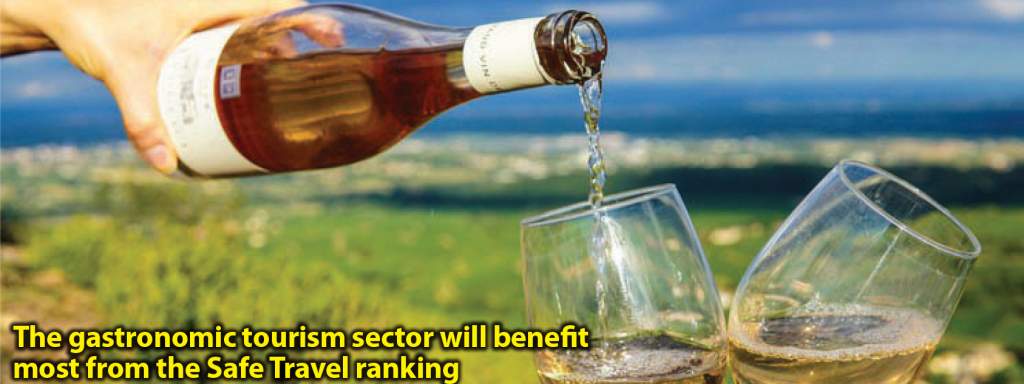Reactivating Tourism Will Be Balancing Act

By Wendy Fry
Ziplining over the ocean in Rosarito. Sandboarding the Dunas de las Pintas outside of Mexicali. Snorkeling with whale sharks in San Quintin.
With the aim of safely reactivating the tourism economy in the border region, Baja California tourism officials are featuring the best the state has to offer in broadcast ads and virtual tours.
It’s enough to make anyone who has “stayed at home” for the past 11 months drool and daydream about future adventures.
And that’s exactly the goal.
“Although we are not promoting current tourist activity as such, we are positioning tourist destinations in the mind – in the memory of potential travelers,” said Mario Escobedo, the Secretary of Sustainable Economy and Tourism for Baja California.
“Once we reactivate ourselves, once we break the back of the COVID, and reintegrate ourselves, well then, we will remind them which are the destinations in Baja California that they can visit,” he added.

But reactivating the tourism economy in the border region amid the final stages of the coronavirus pandemic will be a tough balancing act, he conceded. Too much tourism activity may increase cases enough to bump the state back up to the highest level of alert, shuttering for a third time gyms, casinos and churches.
Not enough visitors impact the employment of some 900,000 tourism sector workers, who lack safety nets like unemployment checks when business slows to a crawl.
Like everywhere else in the world, tourism has been hit hard by COVID-19 in both Baja California and Southern California. As a major economic driver onboth sides of the border, the sudden fall in tourists is having severe economic and social consequences that spill beyond tourism, especially on the southern side of the border where residents do not receive stimulus checks.
Meanwhile, the coronavirus rages on with some hospitals in Tijuana reporting more than 90 percent occupancy as of Jan. 20.
The northern Mexican border state has lost 6,358 patients to COVID-19 with more than 39,000 documented cases since the pandemic began. It has some of the highest numbers in all of Mexico and health experts say those documented figures are likely only a fraction of the actual cases because of a lack of testing.

On the other side of the border, San Diego County had the fourth most coronavirus cases and deaths in the past week compared to all other U.S. counties, federal data shows. There have been 217,000 documented cases with 2,109 deaths there since the pandemic began with county officials conducting a robust free testing program for everyone in the community, not just those who fall ill.
Health experts on both sides of the border point to cross-border travel for driving up the rates of infections in the region.
Despite global bans on travel and ongoing border closures, travel between the United States and Mexico continued relatively unchecked through 2020 with most residents continuing with their daily lives that span the border. Families live on both sides of the border, while many essential workers in San Diego find affordable housing in Tijuana.
A ban on nonessential land travel across the border between the two countries went into effect on March 21, 2020, and continues to get extended with the latest extension lasting until at least Feb. 21. Crossborder travelers say they give border officials an “essential” reason for their trip even if its “essentiality” is questionable – or they pair-up essential errands like picking up medicine with leisure activities.
Meanwhile, news stories abound about young American Spring Breakers beer ponging in Los Cabos or mid-level executives taking their Zoom calls next to nearly empty pools in Puerto Vallarta. In November, more than half a million Americans visited Mexico, according to The New York Times.

At the top of the list of Mexico destinations for international travelers was Tijuana with 1.7 million international arrivals in 2020, according to Cross Border Express – a pedestrian bridge linking San Diego with the Tijuana airport. The northern border city had more international arrivals than Puerto Vallarta and just slightly less than Los Cabos.
Tijuana recorded 6.3 million visitors total in 2020, but overall international visitors were down 41.6% from 2019. Aimed at capturing more of those international travel dollars, the airline Volaris offered 1,300 vouchers to the Northwest Hotel Association to encourage visitors and tourists to stay in the northern border state rather than traveling further south.
Adrian Bustamante, President of the Baja California Hoteliers Association, said the vouchers worth 1,000 pesos or about US$50 will help reactivate the tourism economy in Tijuana.
“The hoteliers association joins the tourist reactivation strategy by also offering a discount in some hotels, an electronic voucher worth an additional 1,000 pesos or a discount for your future visit to Tijuana,” said Bustamante. “Working hand in hand with airlines such as Volaris, it will be possible to reactivate the economy in the shortest possible time. We are convinced that together we will promote the recovery of the tourism sector.”
In October, Escobedo announced the implementation of more than 200 health protocols specifically for the tourism sector, earning the state of Baja California the Safe Travel Seal from the World Travel and Tourism Council. The state official held workshops for three months with tourism officials across the region to earn the certification.
The strategy was to promote safe travel by responsible COVIDconscious visitors to help support the 900,000 workers in the state’s tourism sector.
The gastronomic tourism sector will benefit most from the Safe Travel ranking, according to the president of the gastro-tourism cluster Martín Muñoz, who said just reactivating trips for those who travel from Mexicali to Tijuana for a nice dinner out would be beneficial to the economy.
Some 3,000 restaurants in Baja California were certified to operate under the Safe Travel seal, which is endorsed under the World Health Organization.
“We’ve been attracting the clientele we want – those who are very conscious of the necessary health precautions. The ones who stopped coming during the pandemic for safety reasons,” said Muñoz.
The president of the Tijuana (Cotuco) Tourism and Convention Committee, Carlos Cruz Archundia, applauded the strategy of encouraging the flow of “responsible visitors and tourists.”
The Center for Disease Control explicitly advises against all travel to Mexico right now. Given the mixed messages, it can be hard for travelers or would-be travelers to know what to do, causing more loss San Quintin to potential business.
The decline in travel statewide hit some businesses forever. Last year, Baja California registered 17.6 million visitors, which was 10.4 million less than the 28 million tourists registered in 2019.
“There has been a large percentage of permanent closings, especially in restaurants, small hotels and some tour operators have also decided it was better to close their business,” said Ivette Casillas, the state’s undersecretary for tourism. Some of that activity may take a long time to rebound, she said.
Tourism officials may focus on rebounding regional travel once border restrictions are lifted. While U.S. citizens have been allowed to cross freely into Mexico and back into the United States, Mexican residents have not been able to cross into San Diego except to perform essential work.

A recently released study from SANDAG, the San Diego Association of Governments, found shopping is the primary reason for Mexican residents in Baja California to cross into San Diego, accounting for more than 52% of all trips.
Nowhere in San Diego County is the absence of that traffic hitting harder than in San Ysidro, just on the other side of the border from Tijuana. Ninety-three percent of business in the small community south of downtown San Diego comes from Mexican shoppers.
San Ysidro Chamber of Commerce Director Jason Wells said 105 businesses in San Ysidro’s business district have closed amid the pandemic. He said stabilizing border waits and not going back and forth with border closures will help some economic activity rebound.
“Uncertainty about border closures impacts San Ysidro hard,” said Wells. “Except for bordercrossing employees, most crossborder trips are voluntary. People come to shop, visit family or for tourism. This means any uncertainty regarding the efficiency or closure of the border will cause trips to be delayed. Any delay in trips will directly affect San Ysidro’s US$2 million (pre-COVID) average daily sales.”